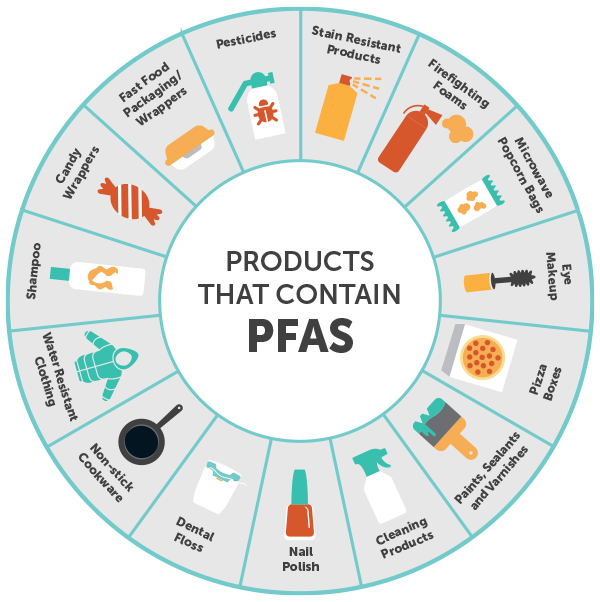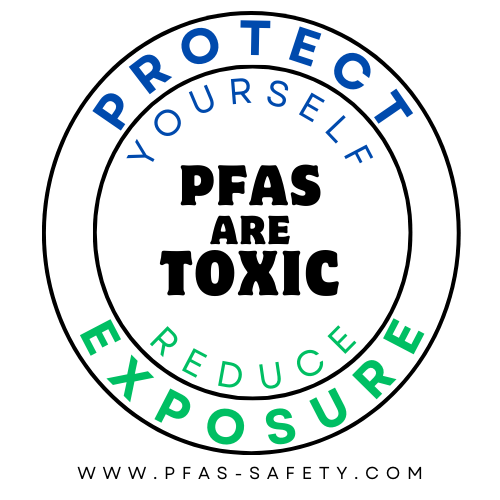Where and how are you exposed?
Home Water

PFOA and PFOS are the two most common PFAS contaminants in water.
Select a filtration solution that has the highest reduction for those.
A number of studies have been conducted to determine the efficiency of filtration devices, for point-of-use. Based on the studies there are currently three types of filtration systems that can reduce PFAS levels in water. They all require that you maintain them by making sure the filters are changed as needed.
There are three categories of home water filtering with varying effectiveness and cost. Find one that fits your budget and works best for you.
- Drinking Water Filtration
~ Water Pitcher Filtration
~ Inline External Refrigerator Water Filtration - Drinking AND Cooking Water Filtration
~ Faucet mounted filtration
~ Under-sink filtration - Whole house filtration system
The three filtration approaches are:
- Reverse Osmosis
- A water treatment process that removes contaminants from water by using pressure to force water molecules through a semipermeable membrane.
- Granulated active carbon (GAC)
- A water treatment system that uses Granular activated carbon (GAC). GAC is made from raw organic materials (such as coal) that are high in carbon which attracts contaminants to the filters surface and holds them. GAC filters are often referred to as charcoal filters.
- Granulated active carbon (GAC) used with osmosis
- A water treatment process that combines reverse osmosis with a GAC filter.
When choosing the system that works best for you in terms of budget and effectiveness take into consideration:
- Filter effectiveness
- How effective is the filter in capturing PFAS and other contaminants.
- Filter capacity (filter life)
- A high-end whole-house system can have a capacity of closes to one million gallons before requiring a change. Water pitcher filtration treats between 50-100 gallons over one to three months. To assure it effectiveness against PFAS you will need to change it closer to every month.
- Look at the cost of filter replacement on the system you select and take that into consideration in your decision.
- Initial Cost of system
- What does it cost to purchase the item and what does the initial purchase come with.
- Replacement Filter cost and how often do you need to change them.
- How much are replacement filters, how often do you need to change them and what is the estimated annual cost?
- Water quality
- Most filtration systems remove chlorine, mercury, copper, zinc, and other heavy metals, but some do more removing additional contaminants including PFAS.
- Flow rate
- Flow rate becomes especially important with whole-house systems. If its too low, you will notice a significant drop in water pressure when using water in several places (ie, clothes washing machine, dish washing machine, shower, sinks, toilets, etc.).
- Installation and maintenance
- Installation of a whole-house system isn’t complex but you will want to hire a professional as they require the system be placed on the point of entry of your home water.
- Maintenance is typically easy as the manufacturers have designed them that way.
Home Products


Many of the home products used daily contain PFAS. (see below)
Clearly its unreasonable to replace them all but if you take a few steps you can remove a lot of your exposure.
Specifically, replace your non-stick cookware, replace your food storage containers with glass or ceramic alternatives, and replace some of your home cleaning products.
Also, opening windows helps circulate the air and prevents exposure to toxic chemicals in stagnant indoor air and dust.
Please refer to the “Interactive PFAS Reduction Solution Generator” for direction on how best to address replacing some of you home products with PFAS-free alternatives.
Food Packaging

Food packaging from many restaurants and stores contain PFAS.
The packaging is used to prevent grease and water soaking through food wrappers and beverage cups.
It can also be found in the ink used to print logos and instructions on food containers.
While you can’t do anything about this, you can replace the food containers you use within your home with glass or ceramic alternatives.
Control what you can.
The Food and Drug Administration (FDA) announced, dated February 24, 2024, that grease-proofing materials containing PFAS are no longer being sold for use in food packaging in the US. This means the the primary source of PFAS from food packaging like fast-food wrappers, microwave popcorn bags, take-out paperboard containers and pet food bags is being eliminated.
The issue with food packaging used by restaurants and stores has been addressed.
But, the FDA allowed manufacturers and users of existing product inventory to let those inventories move through the system.
It is expected that it will take two years, or so, to work through those inventories.
Note that the FDA has authorized certain PFAS, remember there are thousands of chemicals in the PFAS family, for limited use in cookware, food packaging and food processing equipment.
So the FDA has taken steps, but, while measurably smaller, the risk remains.
Food

The short of it is that there has not been enough widespread testing to really know how compromised our food supply is with PFAS.
Testing is ongoing but this link to a video post from CNN titled “‘They told us that this material would be safe’. Toxic PFAS discovered on US farms” and dated May 2, 2024, provides a clear view on how this happened.
https://www.cnn.com/2024/05/02/us/video/pfas-forever-chemicals-farmland-food-biosolids-digvid
The U.S. Food and Drug Administration (FDA) is working to better understand the cycle of how PFAS enters the food supply by testing for certain PFAS chemicals.
The widespread use, together with the long-lasting nature, has resulted in a widespread PFAS environmental contamination.
Contamination is mainly the result of bioaccumulation in water and land food chains and also the use of PFAS-containing food contact materials (packaging).
Farm products grown in PFAS contaminated areas, or farms that have, or currently, use biosolids for fertilizer likely do have some PFAS.
What can you do?
Not much unfortunately.
Food is already very expensive, and the ability to change where you get it is limited.
Going organic isn’t necessarily the solution as organic farms operating in contaminated areas are exposed just like non-organic farms.
So, back to the old rule, control what you can.
What are PFAS?
What are PFAS?
PFAS is a family of thousands of man made chemicals.
PFAS chemicals don’t degrade easily; they stick around in the human body and the environment for a long time, and they are very stable in water.
That’s why some people call them “forever chemicals.”[i]
PFAS ARE TOXIC.
They are in our drinking water, many of our everyday home products, our food packaging, and our food.
PFAS History
“In 1946, Dupont introduced nonstick cookware with Teflon. Today the family of fluorinated chemicals that sprang from Teflon includes thousands on nonstick, stain-repellant, and waterproof compounds called PFAS, short for per- and polyfluoroalkyl substances.
PFAS are used in a staggering array of consumer products and commercial applications. Decades of heavy use have resulted in contamination of water, soil, and the blood of people and animals in the farthest corners of the world. PFAS are incredibly persistent, never breaking down in the environment and remaining in our bodies for years.
Dupont invented the PFAS chemical patent as Teflon, but 3M became its main manufacturer. In 2001, a scandal erupted in Parkersburg, W. Va., after discovery of the Teflon chemical in the drinkign water of tens of thousands of people near a Dupont plant. (The story is documented in the film “The Devil We Know.”)
A class-action lawsuit uncovered evidence that DuPont knew PFAS was hazardous and had contaminated tap water but didn’t tell its workers, local communities or environmental officials. The lawsuit also triggered studies linking the Teflon chemical to cancer and other diseases.”[ii]
___________
[i] WBUR, “What are PFAS chemicals, and should I be freaking out about them?”, March 15, 2023, author Barbara Moran,https://www.wbur.org/news/2019/11/08/what-are-pfas
chemicals-and-should-i-be-freaking-out-about-them
[ii] EWG, “What are PFAS chemicals”, sourced February 28, 2024, https://www.ewg.org/what-are-pfas-chemicals
Jobs with PFAS exposure
Some industries where workers may face higher PFAS exposure include:
Manufacturing Facilities:
Workers involved in the manufacturing of PFAS-based products, such as textiles, nonstick coatings, firefighting foams (Aqueous Film Forming Foams, or AFFF), and industrial chemicals, may have significant exposure to PFAS during production processes.
Textile and Apparel Industry:
Workers involved in textile manufacturing, especially those producing water-repellent or stain-resistant fabrics treated with PFAS, may encounter PFAS during various processing stages, such as fabric treatment and finishing.
Electronics Manufacturing:
Workers in the electronics industry, particularly those involved in the production of semiconductors, circuit boards, and electronic components, may be exposed to PFAS using PFAS-containing materials in manufacturing processes, such as photoresists and etchants.
Metal Plating and Finishing:
Workers in metal plating and finishing facilities, where PFAS-containing substances are used as surfactants or additives in electroplating baths and metal finishing processes, may have elevated PFAS exposure risks.
Firefighting and Emergency Response:
Firefighters, airport rescue personnel, and other emergency responders who use firefighting foams (AFFF) containing PFAS to suppress flammable liquid fires may experience high levels of PFAS exposure during training exercises, fire suppression activities, and cleanup operations.
Food Packaging and Processing:
Workers involved in food packaging and processing industries may encounter PFAS through contact with food packaging materials treated with PFAS-based coatings or through contamination of food products by PFAS-containing equipment or processing aids.
Landfill Operations and Waste Management:
Workers involved in landfill operations, waste management, and recycling facilities may be exposed to PFAS from the disposal of PFAS-containing products, leachate from landfills, and the handling of contaminated waste materials.
Tanneries and Leather Processing:
Workers in tanneries and leather processing facilities may face PFAS exposure risks from the use of PFAS-based chemicals in leather finishing processes, such as water repellents and stain protectors.
Construction and Building Materials:
Workers involved in construction activities, particularly those using PFAS-treated building materials such as carpets, sealants, and waterproofing membranes, may be exposed to PFAS during installation, renovation, or demolition work.
Chemical Industry:
Workers in the chemical manufacturing and processing industries may encounter PFAS as byproducts, intermediates, or raw materials in various chemical synthesis and production processes.
Vulnerable Groups
Residents in Contaminated Areas.
People living near industrial sites, military bases, or firefighting training facilities where PFAS are used or manufactured face higher exposure risks due to contaminated water supplies and soil.
Pregnant Women.
PFAS can cross the placenta, potentially affecting fetal development. Pregnant women exposed to high levels of PFAS may have higher risks of pregnancy-induced hypertension and preeclampsia.
Infants and Children.
Children are more susceptible to PFAS due to their developing bodies and behaviors like hand-to-mouth activity.
“Breastfeeding infants may be exposed to PFAS since these chemicals have been found in breast milk. The benefits of breastfeeding are well known and usually outweigh the potential risks of trace contamination. Consult a physician for further information or concerns.”[iv]
Communities with limited resources.
Economically disadvantaged communities may lack the infrastructure or resources to adequately address PFAS contamination in their environment, leading to higher exposure levels.
People consuming contaminated food.
Populations relying heavily on locally sourced food (like fish from contaminated water bodies) are at higher risk.
Elderly population.
Older adults may have accumulated higher levels of PFAS over time due to the chemicals’ persistence, potentially leading to more pronounced health effects.
